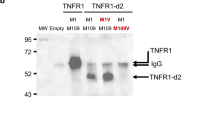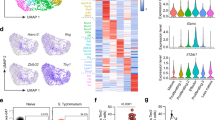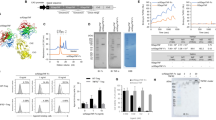Abstract
By searching an EST database, we identified two TNF receptor superfamily members (named mTNFRH1 and mTNFRH2). Amino acid sequences are highly conserved between the two receptors (78% identity). The chromosomal loci of mTnfrh1 and mTnfrh2 genes are found in distal chromosome 7 in the mouse. mTNFRH1 and mTNFRH2 do not contain the cytoplasmic domain, indicating that they might function as decoy receptors. Furthermore, an alternatively spliced form of mTNFRH1 was found which contains neither the transmembrane domain nor the cytoplasmic domain, thus presumably existing as a soluble form. Northern blot analysis showed that mTnfrh1 mRNA was negligibly expressed in tissues, while mTnfrh2 mRNA was strongly expressed in spleen, lung, liver, kidney, and testis. When the extracellular domains of mTNFRH1 and mTNFRH2 were expressed in bacteria, their molecular weight of extracellular region was approximately 15 kDa. Both of the soluble forms were effective in inhibiting T-cell proliferation stimulated by anti-CD3 monoclonal antibody. Our data suggest that mTNFRH1 and mTNFRH2 may be implicated in exerting a modulatory role in the immune response.
Similar content being viewed by others
Article PDF
Author information
Authors and Affiliations
Rights and permissions
This is an Open Access article distributed under the terms of the Creative Commons Attribution Non-Commercial License (http://creativecommons.org/licenses/by-nc/3.0/) which permits unrestricted non-commercial use, distribution, and reproduction in any medium, provided the original work is properly cited.
About this article
Cite this article
Kim, J., La, S., Kim, BS. et al. Newly dentified members of the TNF recept or superfamily (mTNFRH1 and mTNFRH2) inhibit T-cell proliferation. Exp Mol Med 35, 154–159 (2003). https://doi.org/10.1038/emm.2003.21
Published:
Issue date:
DOI: https://doi.org/10.1038/emm.2003.21
Keywords
This article is cited by
-
Chronic airway-induced allergy in mice modifies gene expression in the brain toward insulin resistance and inflammatory responses
Journal of Neuroinflammation (2013)



